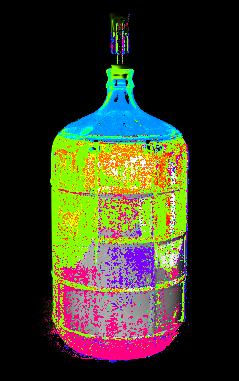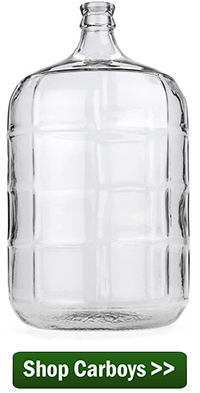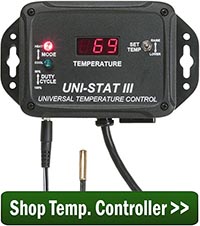 Could you tell me how I might control my fermentation temperature? I have been making wine for 15 or so years from real grapes. Many times the wine’s fermentation temperature is too high. What is the best way to control it. Thanks in advance.
Could you tell me how I might control my fermentation temperature? I have been making wine for 15 or so years from real grapes. Many times the wine’s fermentation temperature is too high. What is the best way to control it. Thanks in advance.
Name: Al J.
State: NY
—–
Hello Al,
Thanks for the great question. This is something that plagues a lot of home winemakers, so I’m glad you brought it up.
For those of you who do not know, a fermentation creates heat. It’s usually not a problem during the cooler months or with smaller batches, say 5 gallons or less. But when the weather is hot or you are fermenting in 15 gallon batches or larger, heat can build up and should be on the winemaker’s radar.
Depending on the type of wine you are making and the type of wine yeast you are using, you would like your fermentation to around 70° to 75° F. Once you start getting over 80°F. you run the risk of off-flavors and possible spoilage.
There are several ways you can go about keeping a fermentation cool. Unfortunately, most of them are a pain in the behind. For a professional winery it simple. They use fermentation vats with cooling jackets and/or refrigeration coils that keep the temperature stable under computerized control. Sweet! But for us home winemakers we have to use a little more ingenuity to keep our fermentation temperatures stable.
I’ll go through a few of the basic methods you can use if the wine fermentation temperature is too high, but it’s going to be up to you to figure out which one is going to be most practical for your situation:
- Use Smaller Fermenters
This one is pretty basic. A 5 gallon carboy is not going to over-heat as easily as a 15 gallon demijohn. This is because you have more external surface area per gallon as you go down in size. That means the heat can dissipate more readily from a smaller fermenter than it can with a larger fermenter.
- Blocks Of Ice
 This is the one I hate the most, but is most used by home winemakers. It’s simply using blocks of ice in ziplock bags directly into the wine. I hate this for two distinct reasons: 1) you never know when a ziplock bag is going to fail and empty melted ice into the wine, 2) there is very little control. While it’s designed to help you out when the wine fermentation temperature is too high, you could easily get the fermentation too cool, stalling the fermentation. For these reasons I do not recommend this method, but it could be used in a pinch.
This is the one I hate the most, but is most used by home winemakers. It’s simply using blocks of ice in ziplock bags directly into the wine. I hate this for two distinct reasons: 1) you never know when a ziplock bag is going to fail and empty melted ice into the wine, 2) there is very little control. While it’s designed to help you out when the wine fermentation temperature is too high, you could easily get the fermentation too cool, stalling the fermentation. For these reasons I do not recommend this method, but it could be used in a pinch.
- Evaporation Method
The basis behind this method is when water evaporates it cools whatever it is touching. By keeping evaporating water against the outside of the fermenter, you can get the fermenter to cool down. A common way of accomplishing this is to sit the fermenter in a bath of water. It does not need to be deep, just a few inches. Next put fabric over the fermenter that drapes into the water. As an example, you could use a cotton t-shirt over a carboy. The water will then wick up the fabric and then evaporates, cooling the fermenter. You an use a fan to blow air across the fermenter to speed up the evaporation. The faster the evaporation, the more the fermentation gets cooled.
- Heat Ex-changer
This method is done simply by putting a coil of stainless steel tubing in the wine and then running cold water through the tube. This is a great way to cool the wine. The biggest problem with it is that you have to use stainless steel tubing which is expensive. Other metals will corrode which is detrimental to the wine, so stay away from copper, aluminum, etc.
and then running cold water through the tube. This is a great way to cool the wine. The biggest problem with it is that you have to use stainless steel tubing which is expensive. Other metals will corrode which is detrimental to the wine, so stay away from copper, aluminum, etc.
- Dedicated Refrigerator
This is the ultimate solution for when a wine fermentation temperature is too high. This method involves using a refrigerator as a temperature controlling device. The obvious issue with this method is you need a refrigerator. The second issue is that the thermostat of a refrigerator does not go high enough. For this reason you will need to buy a electronic temperature controller with the correct temperature range to control the power to the refrigerator.
Unfortunately, all these methods involve some effort on your part. As mentioned before, all them work, it’s more a matter of picking out the method that is most practical for your situation.
Happy Winemaking,
Ed Kraus
—–
Ed Kraus is a 3rd generation home brewer/winemaker and has been an owner of E. C. Kraus since 1999. He has been helping individuals make better wine and beer for over 25 years.

Guy, hooking up the thermostat is very simple. The one linked to in the above post is a power interrupter thermostat. It plugs in between the wall outlet and the power cord of the refrigerator. Set the refrigerator’s built-in thermostat to as low as it will go. Put the probe temperature sensor from the external thermostat into the refrigerator. Its cord is small enough that you can shut the refrigerators door on it. After that all you have to do is set the temperature you want on the external thermostat. Power will only be supplied to the refrigerator when the set temperature is reached.
Do you have instructions for connecting the temporary thermostat mentioned above to a refrigerator?
I usually only make 3-5 gallons at a time. To control the temperature of my wine making I added an 8X8 room onto my storage building that I call my wine cellar. Since I live in the hot and humid state of Louisiana close to LAFFAYETT I control the temp. with a small 110v a/c. Works great for maintaining 73 deg.
Two of my last 5 batches of wine, where only muscadine grapes were used, resulted in a wine that taste good, but it spewed when opened and was bubbly (like a champagne). The taste changed also! Campten & potassium sorbate were added at bottling. Do you have any suggestions as to the cork blowing cause. I started with fruit wines in the 1990s & don’t remember this event before.
Gordon, there are normally two reasons that can cause this to occur, fermentation activity or a bacterial infection. You mention that you added potassium sorbate, before you added it had you verified with your hydrometer that the fermentation was in fact complete? Potassium sorbate will not stop a fermentation that did not complete. We have posted an article below that will provide more information regarding why your wine is fizzy.
Fizzy Homemade Wine
http://www.eckraus.com/blog/fizzy-homemade-wine
We make 20 to 40 gallon batches indoors, heated in winter and cooled in summer. Our Blueberry wine made in early fall is monitored so that the temperature does not get too cool for fermentation, the larger volume helps to keep a more consistent temperature. Our Strawberry and Blackberry wine made in early summer are more susceptible to warmer fermentation temperatures so the room is kept cooler and we include Ghostex ,Yeast Nutrient and Yeast Energizer in the recipes. The yeast are very happy and the primary fermentation moves along pretty quickly { s.g. 1.08 to 1.02 in 3 or 4 days} so a warmer environment is less of a problem. Ghostex helps to create a clean alcohol and prevent off flavors due to a warmer fermentation so it is included in every batch we make.
I have been fermenting wine in my basement for eleven years. The temperature is a constant 60 to 65 degrees and i have never had a problem with any of the 2000 + bottles I’ve made. You may note that many of the wine kits recommend 60-65 degrees as a desirable temperature for all stages of the fermenting to bottling process. Therefore, don’t be concerned if the temperature is below 70-75 degrees, it should be fine. Additionally, I rack my red wines for one year and whites for at least 6 months; again at the same temperature I indicate above.
hi There
After racking your wine for a yr for Reds , do you filter then add suphite before bottling ? How much sulphite do you add Thanks.
Need some advice or comments…I ferment my wine in an upstairs room and it’s generally always controlled by my heating/cooling system. The power went out and for about a day and a half the temps in my room got above 90 while into my my second racking. I’ve racked again and it seems to taste ok…should I be concerned and/or is this batch ruined?